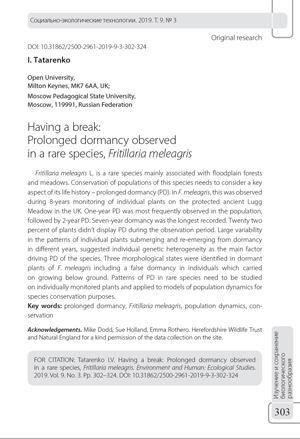NEWS 2019
Having a break: Prolonged dormancy observed in a rare species, Fritillaria Meleagris
I TATARENKO
Environment and Human: Ecological Studies. 9 (3): 302–324 (2019)
https://doi.org/10.31862/2500-2961-2019-9-3-302-324
Open University, Milton Keynes, MK7 6AA, UK and Moscow Pedagogical State University, Moscow, 119991, Russian Federation
Abstract
Fritillaria meleagris L. is a rare species mainly associated with floodplain forests and meadows. Conservation of populations of this species needs to consider a key aspect of its life history – prolonged dormancy (PD). In F. meleagris, this was observed during 8-years monitoring of individual plants on the protected ancient Lugg Meadow in the UK. One-year PD was most frequently observed in the population, followed by 2-year PD. Seven-year dormancy was the longest recorded. Twenty two percent of plants didn’t display PD during the observation period. Large variability in the patterns of individual plants submerging and re-emerging from dormancy in different years, suggested individual genetic heterogeneity as the main factor driving PD of the species. Three morphological states were identified in dormant plants of F. meleagris including a false dormancy in individuals which carried on growing below ground. Patterns of PD in rare species need to be studied on individually monitored plants and applied to models of population dynamics for species conservation purposes.




